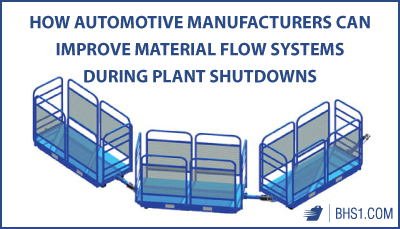We use cookies to make your experience better. To comply with the new e-Privacy directive, we need to ask for your consent to set the cookies. Learn more.
How Automotive Manufacturers Can Improve Material Flow Systems During Plant Shutdowns
Automotive manufacturers can't push out the next big model without retooling plants, and that means periodic shutdowns at factories across the U.S. But while teams of workers busily upgrade assembly lines, plant managers also stay busy planning to move the entire operation forward.
Disruptions of day-to-day plant operation create tremendous opportunities for improvement. This is especially true in the automotive field, where idling factories aren't necessarily a sign of tight resources. Manufacturers often plan downtime to coincide with inventory surplus in a delicate balancing act that ensures delivery of highly marketable cars and trucks with virtually each new model year. 
This combination of yearly renewal, expendable capital, and a momentary disruption to a plant's status quo make retooling season an ideal time to improve processes outside of the assembly line itself — including part-feeding systems and strategies. Here are two great ways automotive manufacturers can improve material flow in tandem with upgrading assembly lines:
Optimize Lineside Delivery
The assembly line can't function if parts and components aren't where they need to be, precisely when they should be there. Sometimes, even in the heavily automated world of automotive manufacturing, that means trusting material flow to manually operated material handling equipment — and many operations find that tugger trains are the most versatile way to get parts to the line in a flexible, efficient, and low-cost way.
A new generation of Tugger Trailers offers custom design for unique applications. With differently configured Tugger Trailers, the same material-handling train can deliver heavy wheel-well liners or bins of tiny ball bearings in a single run. That boosts productivity without the tremendous expense of new automated systems and teams of industrial robot operators.
Many automotive manufacturers are moving away from unit-load delivery to workstations, as well. While nothing beats an electric forklift for full pallet-loads, tugger trains are better-equipped to handle diverse individual units or pre-packaged parts kits designated for a particular assembly workstation. Which brings us to our next point.
Rethink Lineside Storage Strategies
What's the best way to store parts lineside? In a 2012 study published in the International Journal of Production Research, Limère et al. compare the relative merits of line stocking and kitting. In a line stocking system, boxes or unit-loads of identical parts sit directly at assembly workstations in their original packaging. Kitting involves a preliminary step: packaging complementary or related parts into a single container before sending it to the line, where space is limited.
Kitting takes up less space, but line stocking requires less time. In their study, Limère et al. recommend a hybrid approach to lineside material supply. Industrial engineers should look at each part individually, they say, determine which system is more cost-effective, and choose between kitting and line stocking accordingly.
See the authors' mathematical cost model for making this decision for each part here (behind a paywall in this link — you might also be able to access the article through your local library's reference databases).
Making the Most of an Idling Automotive Factory
Until we develop incredibly flexible, decentralized automated manufacturing systems for cars and trucks, plant shutdowns will remain a fact of the industry. It's easy to focus on the assembly line during an annual retool, but improving material flow is a vital part of keeping the line moving efficiently, during the next model year and beyond — and luckily, those options are here already.
References:
Limère, Veronique, et al. "Optimising Part Feeding in the Automotive Assembly Industry: Deciding between Kitting and Line Stocking." International Journal of Production Research, vol. 50, no. 15, Aug. 2012, pp. 4046-4060. EBSCOhost, doi:10.1080/00207543.2011.588625.
Rogers, Laurie. "Automotive: Make lineside delivery count." MMH. Peerless Media LLC, 1 Jun. 2012. Web. 31 May 2018.
